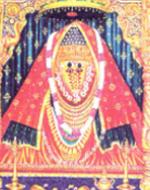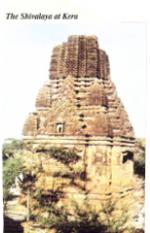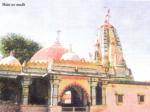From Bhuj, the capital of erstwhile state of Kutch, about 80 km to the north is the temple of Ma Ashapura at Mata no Madh. It has become a live symbol of faith of people of Kutch in the last 600 years.
In 14th century two Karad Vanias, Ajo and Anagor had this temple built. They were ministers in the court of the father of Lakho Fulani. The severe earthquake in 1819 badly damaged the temple. Within 5 years Sundarji Shivji and Vallabhaji, the two persons of Brahmakshatriya caste repaired it. This ancient temple is now 58 ft. long, 32 ft. wide and 52 ft. tall. Once again the earthquake of 2001 AD shook it and its dome tumbled down. However, very soon it was repaired once again and now it stands with a new grandeur. The image of its deity, Ma Ashapura, is 6 ft. tall, 6ft. wide and is red in cot"or.It is said to be existing on its own, i.e. 'swayambhu'.
Considered as the Cromwell of Kutch, Jamadar Fateh Muhammad had presented this temple with a 'deepmala' weighing 2 kg silver, and with 41 lamps carved in it. The head of the temple is called Rajabava and his power is still very great. When the ruler of Kutch visits Mata no Madh, inevitably he pays a visit to the temple. At the time the head of the temple sits on the throne and the ruler stands humbly before him. Ma Ashapura is the 'kuldevi' of the 'Jadeja' community of Jamnagar. At the city of Jamnagar also a temple of 'Nani Ashapura' is built. The people of Kutch take care that nothing is missing in their hospitality of the visitors who come on foot most of the time. From Surajbari to the temple at various places tents are set up for resting. In some village such tents are turned into permanent stn..lctures as guesthouses. On the Bhuj - Anjar road and Bhachau - Dudhai road villagers erect relief camps enthusiastically. The pilgrims are served with tea, coffee, or other drinks, snacks, meals, fruits and even medical services like physiotherapy, doctors and medicines. These camps provide services round the clock. A huge camp comes up opposite the Taluka Panchayat building at Bhuj. Within 3 km of this, other 5 camps also come up. Among the pilgrims there are doctors, bank officials and other educated persons too. Many ladies, girls of peasants, girls attending colleges, teachers, rich merchants from distant Mumbai and other places, all come to Kutch and serve. The pilgrims are bidden adieu from the 'Panch-hatdi Chowk' near the temple of Ma Ashapura at Bhuj.
Millions of devotees visit the Mata no Madh to bow down to Ma Ashapura. The road turns into a carpet made of outer skin of dry coconuts. For hours the devotees wait for their turn for 'darshan' and observe discipline on their own to have a glimpse of the image of Ma Ashapura. On the day of Havanashtami the royal family of Kutch remains present at the puja. The 'jatar' is offered to the deity and a ceremony called 'patri' is performed. Here are also the temple of Chachar Mata, and places called Chachar Fand and Chachar Chowk.
NAVARATRI FESTIVAL
Once again the center of Navratri festival in Kutch is Mata no Madh and the temple of Ma Ashapura. As soon as the Shraddha Paksh is over, the pilgrims begin their travel on foot from not just Kutch, Surashtra and Gujarat, but also from as far as Rajasthan, Maharashtra, Andhra Pradesh and Karanataka States. Those coming from Mumbai begin to walk from a month earlier. Some come on bicycles, some come rolling the coconut all the way, some walk without shoes, some arrive swinging children in their cradle, and we find rainbows of faith here. The pilgrims begin to walk with great enthusiasm from places like Mumbai's Ghatkopar, Dadar, Mulund, Snta Cruz, Masjid Bandar areas. 'Mataji ni Topi; orange flag, cotton shoulder bags and Ashapuri 'dhoop' (incense), all enchant the pilgrims.








